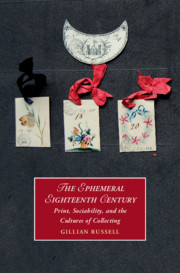Book contents
- The Ephemeral Eighteenth Century
- Cambridge Studies in Romanticism
- The Ephemeral Eighteenth Century
- Copyright page
- Dedication
- Contents
- Figures
- Acknowledgements
- Introduction
- Chapter 1 Accidental Readings and Diurnal Historiographies
- Chapter 2 Making Collections
- Chapter 3 The Natural History of Sociability
- Chapter 4 Sarah Sophia Banks’s ‘Magic Encyclopedia’
- Chapter 5 ‘Announcing Each Day the Performances’
- Chapter 6 Transacting Hospitality
- Chapter 7 England in 1814
- Conclusion
- Bibliography
- Index
- Cambridge Studies in Romanticism
Introduction
‘All the Ephemera of Our Lives’
Published online by Cambridge University Press: 13 August 2020
- The Ephemeral Eighteenth Century
- Cambridge Studies in Romanticism
- The Ephemeral Eighteenth Century
- Copyright page
- Dedication
- Contents
- Figures
- Acknowledgements
- Introduction
- Chapter 1 Accidental Readings and Diurnal Historiographies
- Chapter 2 Making Collections
- Chapter 3 The Natural History of Sociability
- Chapter 4 Sarah Sophia Banks’s ‘Magic Encyclopedia’
- Chapter 5 ‘Announcing Each Day the Performances’
- Chapter 6 Transacting Hospitality
- Chapter 7 England in 1814
- Conclusion
- Bibliography
- Index
- Cambridge Studies in Romanticism
Summary
In the late 1920s in Old Headington outside Oxford, a woman called Lilian Gurden, who was working in the garden of the home of Mrs Dorothea Johnson, was invited inside by her employer for a cup of coffee. Mrs Johnson was the wife of John de Monins Johnson (1882–1956), Printer to the University of Oxford from 1925 to 1946 and the most significant English ephemerist of the twentieth century. Interviewed in 1986 by another important ephemerist, Maurice Rickards, Lilian Gurden (later Thrussell) recalled Dorothea Johnson telling her that she was unable to take a bath because it was ‘full of soaking album pages’. These albums contained printed ephemera from which John Johnson was extracting material for his collection, the ‘Sanctuary of Printing’, housed in an upper room of the printery of the Oxford University Press. Johnson’s interest in paper scraps had been inspired by his early experience as an Egyptologist, ‘digging the rubbish-mounds of Graeco-Roman cities in Egypt for the written materials – the waste paper of those ages’. Encountering long queues outside cinemas in 1920s Oxford as he travelled home from work, Johnson was led to contemplate the relationship between twentieth-century visual media, the cityscape, and advertising as a form of graphic and visual art. His not inconsiderable ambition was to document ‘the miscellany of the world … Trivial things like the development of advertisements on our hoardings … all the ephemera of our lives’.
Keywords
- Type
- Chapter
- Information
- The Ephemeral Eighteenth CenturyPrint, Sociability, and the Cultures of Collecting, pp. 1 - 29Publisher: Cambridge University PressPrint publication year: 2020

